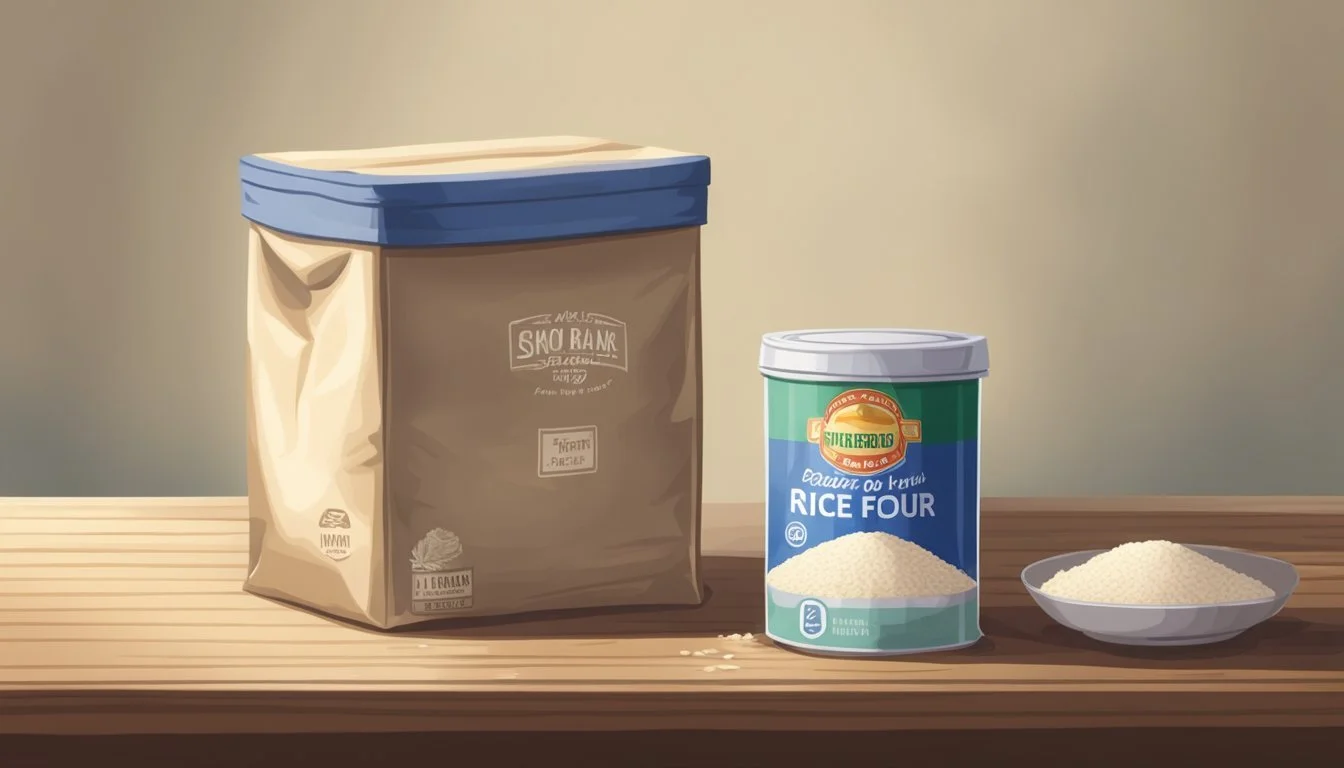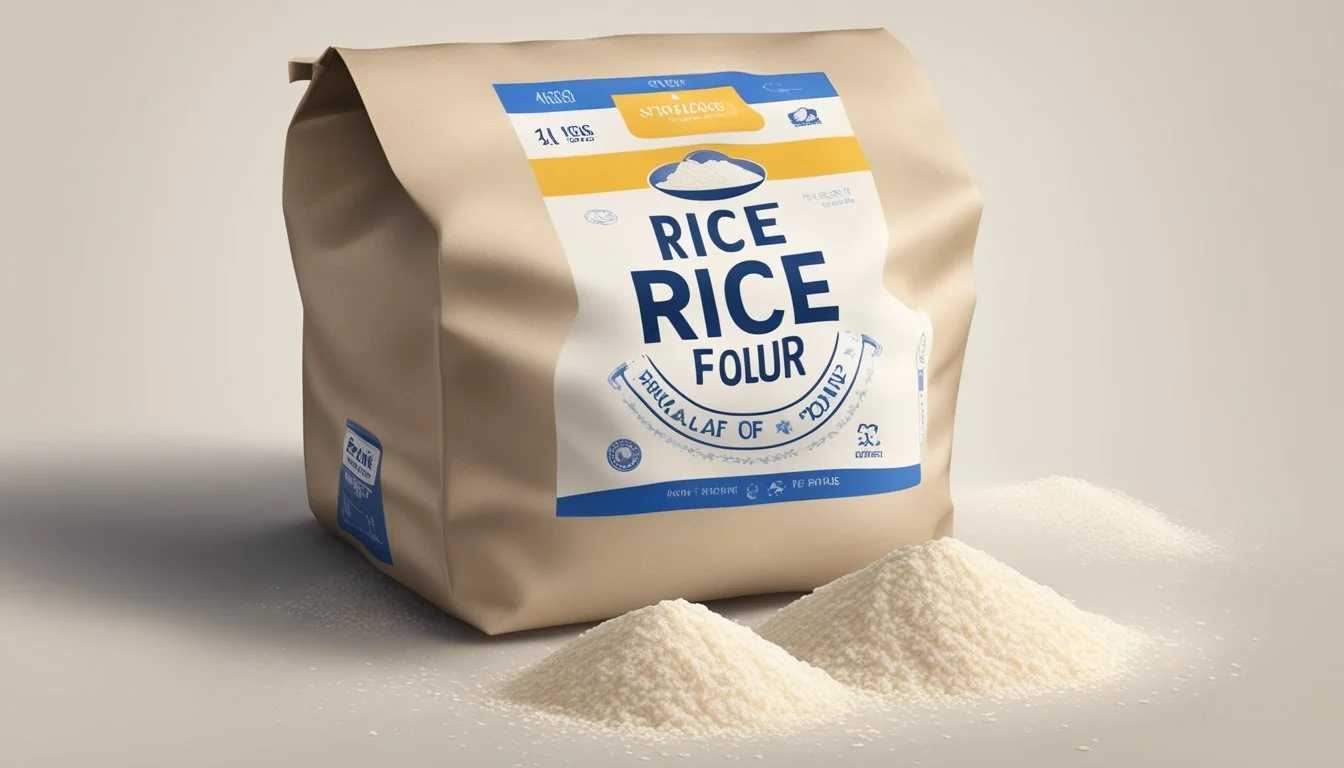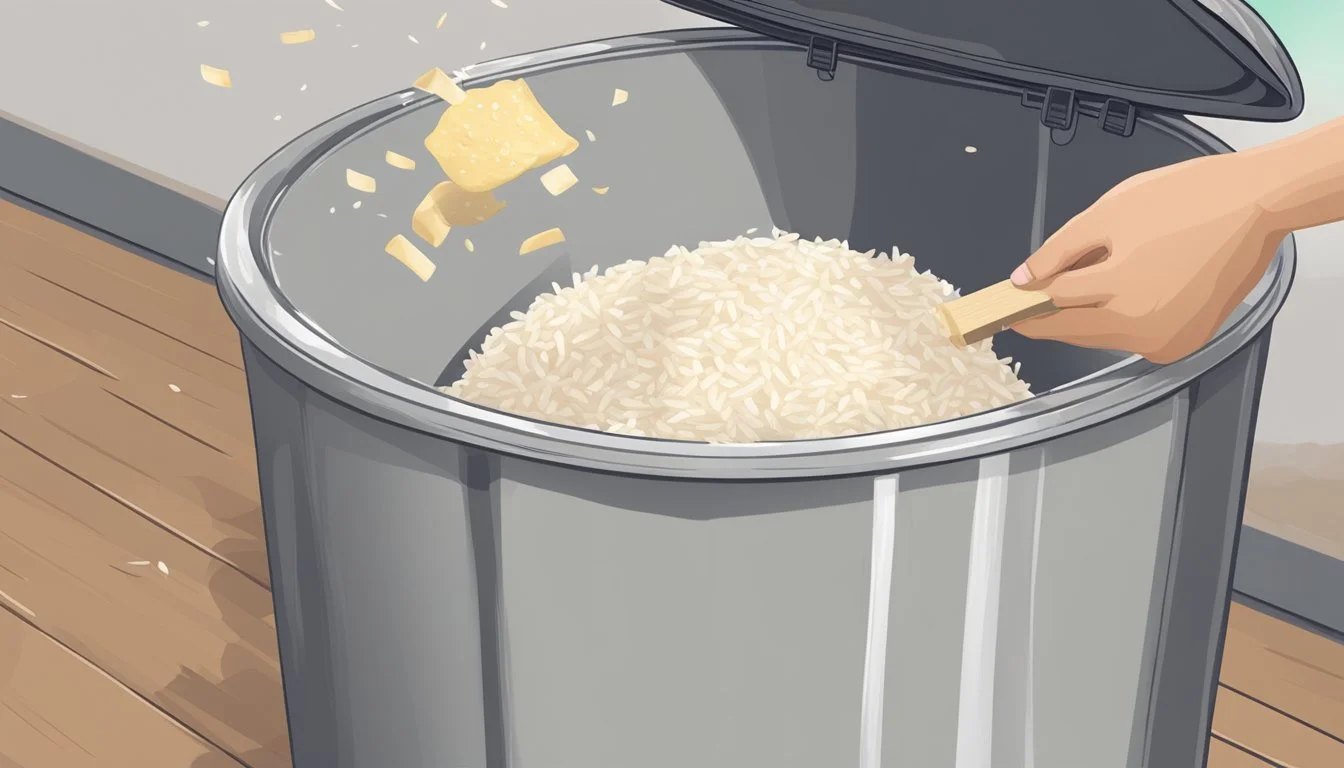Does Rice Flour Go Bad?
Shelf Life & Storage Guide
When using rice flour, a gluten-free alternative gaining popularity, many wonder about its shelf life and potential for spoilage. Rice flour does go bad, influenced by factors like the type of rice it's made from and storage conditions.
Brown rice flour, with its higher oil content, typically spoils faster than white rice flour. Proper storage is crucial; keeping rice flour in a cool, dry place can extend its longevity, but refrigeration or freezing is ideal for maximizing its shelf life.
Detecting rancid rice flour is straightforward—an unpleasant odor or taste indicates spoilage. Whether you're baking or cooking, knowing how to store and assess your rice flour will ensure your dishes remain delicious and safe to consume.
Understanding Rice Flour
Rice flour is a versatile gluten-free flour made by finely grinding rice grains. There are different types of rice flour, each with unique properties, a nutritional profile, and various culinary applications.
Types and Varieties
Rice flour typically comes in two main types: white rice flour and brown rice flour. White rice flour is made from polished white rice, having a milder flavor and smoother texture due to the removal of bran and germ.
Brown rice flour, on the other hand, includes the bran and germ, providing a nuttier flavor and coarser texture but a shorter shelf life due to the natural oils in the bran and germ. Both types offer a gluten-free alternative to wheat flour.
Nutritional Profile
Rice flour is primarily composed of carbohydrates, making it a good source of energy. White rice flour has fewer nutrients compared to brown rice flour due to the refining process that removes the bran and germ.
Brown rice flour retains fiber, vitamins, and minerals, making it more nutritious. For those seeking a gluten-free flour option rich in essential nutrients, brown rice flour is often preferred despite its shorter shelf life.
Culinary Uses
Rice flour is celebrated in gluten-free cooking and baking. It's frequently used to make bread, muffins, and pancakes. White rice flour is ideal for smooth pastries and sauces, while brown rice flour is chosen for denser baked goods and items requiring a heartier texture.
Potential alternatives to rice flour in gluten-free recipes include tapioca flour, potato flour, almond flour, and coconut flour. Each brings unique properties to dishes, allowing for various textures and flavors tailored to specific recipes.
Signs of Spoilage
When rice flour goes bad, it exhibits several clear signs. These include visible changes, unusual smells, and alterations in texture that can help determine its freshness.
Visual Indicators
Visual signs of spoiled rice flour are quite apparent. Mold growth is the most obvious indicator. Mold appears as green, black, or white spots on the flour’s surface. Additionally, discoloration is another warning sign. Fresh rice flour should be white or off-white; any deviation from this, such as a yellow or gray hue, indicates spoilage.
Another visual sign is the presence of clumps. While some minor clumping can occur due to moisture, large or hard clumps signal a problem. Clumping often means that moisture has entered the packaging, which can hasten spoilage.
Olfactory Indicators
The smell is a reliable indicator of rice flour’s freshness. Fresh rice flour generally has a neutral or slightly nutty aroma. If the flour emits a rancid smell, which can be sour or musty, it should not be consumed. This rancid odor results from the breakdown of natural oils in the flour, leading to spoilage.
A sour odor is another red flag. This can occur due to bacterial growth in the flour. An unpleasant or off-putting smell, different from the flour's usual mild aroma, is a strong indication of spoilage.
Texture Changes
Changes in texture provide additional clues. Fresh rice flour has a fine, smooth texture. Spoiled flour may develop a clumpy texture due to moisture absorption. This clumping makes the flour difficult to sift and use in recipes.
Moreover, if the flour feels sticky or damp, it indicates moisture contamination. Such changes in texture not only affect the flour’s usability but also suggest potential spoilage and should be taken seriously.
Factors Affecting Rice Flour Shelf Life
Various elements determine the shelf life of rice flour, including storage conditions and the flour's composition. It's essential to understand these factors to ensure the best quality and safety of the flour.
Exposure to Heat
Heat significantly impacts rice flour's quality. High temperatures accelerate the oxidation process, leading to rancidity. Storing rice flour in cool conditions helps preserve its shelf life.
Ideal storage temperatures for rice flour are below 75°F (24°C). Keeping it in a pantry away from heat sources like ovens and direct sunlight is advisable. Refrigeration can further extend shelf life by slowing down deteriorative processes.
Moisture and Humidity
Moisture is a critical factor affecting rice flour's shelf life. High humidity levels can cause clumping and mold growth. Moist environments increase the risk of contamination, making the flour unsafe.
Using airtight containers can protect rice flour from moisture and humidity. It's better to store it in a cool, dry place to prevent exposure to damp conditions. Refrigerated storage in airtight packaging can further prevent moist air ingress.
Oil Content
The oil content in rice flour, especially brown rice flour, makes it more prone to spoilage. The bran and germ in brown rice flour contain oils that can become rancid over time.
White rice flour, made from polished rice, has a longer shelf life due to the removal of bran and germ. Monitoring storage conditions is crucial for brown rice flour to avoid rapid spoilage.
Packaging Integrity
Packaging integrity plays a vital role in maintaining rice flour's quality. Poorly sealed packages allow air, moisture, and contaminants to penetrate, reducing shelf life.
Using resealable bags or transferring flour to airtight containers immediately after opening can help preserve freshness. Vacuum-sealed packaging offers an added layer of protection against external elements.
By understanding and managing these factors effectively, rice flour can be kept fresh and safe for longer periods. Proper storage practices are essential to extend the flour's usability and maintain its quality.
Proper Storage Techniques
Proper storage of rice flour extends its shelf life and maintains its quality. Storage techniques like pantry storage, refrigeration, and freezing can help preserve its freshness and prevent spoilage.
Pantry Storage
When storing rice flour in the pantry, it is essential to keep it in an airtight container. This prevents exposure to air and moisture, which can lead to spoilage. Choose a cool, dry place away from direct sunlight to store the container.
Ensure that the pantry maintains a consistent and moderate temperature, as fluctuating temperatures can also impact the flour's quality. Using opaque containers can be beneficial to prevent light exposure, which might degrade the flour over time.
Refrigeration
For extended freshness, refrigeration is a valuable option. Place the rice flour in an airtight container to avoid absorption of moisture and odors from other foods. The container should be stored at the back of a refrigerator shelf where it is coldest.
Refrigeration slows down the oxidation process, thereby preserving the natural oils in the flour. Avoid frequent opening and closing of the container to maintain the low temperature and humidity levels necessary for optimal storage.
Freezing
Freezing rice flour offers the longest storage life while maintaining its quality. Use a freezer-safe, airtight container or heavy-duty freezer bags to store the flour. Label the packaging with the date to keep track of its storage duration.
The freezer should be kept at a consistent, low temperature to prevent the flour from absorbing moisture and odors. When needed, thaw the flour in small amounts to avoid repeated freezing and thawing cycles, which can compromise its quality.
These detailed techniques help ensure rice flour remains fresh and safe for consumption over an extended period.
Common Storage Mistakes
Proper storage of rice flour is vital to maintain its quality and prevent spoilage. Avoiding common mistakes can help extend its shelf life.
Exposure to Contaminants
Rice flour can easily become contaminated if it is not stored in a suitable environment. Insects like weevils and other bugs are attracted to flours and grains. Storing rice flour in a pantry without proper protection can lead to infestations.
Moisture is another significant contaminant. Rice flour absorbs moisture from the air, leading to clumpiness and promoting mold growth. Always ensure that storage areas are dry and the flour is kept in a tightly sealed container.
Storing rice flour next to strong-smelling substances can cause it to absorb odors, which can negatively affect its taste. Keep it away from spices and scented items to avoid this issue.
Inadequate Containers
Using inappropriate containers is another common storage mistake. Containers that are not airtight allow air and moisture to reach the flour, which can cause it to go bad quickly. Airtight containers or vacuum-sealed bags are the best options to keep rice flour fresh.
Plastic bags or flimsy packaging do not provide sufficient protection against air, light, and pests. Always transfer rice flour into sturdy, airtight containers immediately after opening the original packaging.
Storing rice flour in clear containers can also be problematic. Light exposure accelerates the oxidation process, leading to rancidity. Use opaque or dark-colored containers to block out light and extend the flour's shelf life.
Lastly, label containers with the date of purchase or expiration to keep track of freshness and avoid using old flour that might have gone bad.
Rice Flour Expiration
Rice flour does expire, and its shelf life is influenced by several factors such as its composition, packaging, and storage conditions. Knowing how to interpret expiration labels and understanding the difference between freshness and safety can help ensure that rice flour is used appropriately.
Understanding Expiration Labels
Expiration labels on rice flour packages can include terms like best-by and use-by dates. The best-by date generally indicates the period when the product is expected to retain its best quality. After this date, the rice flour might still be safe to eat but could lose its freshness and taste.
Use-by dates are more critical as they suggest the last date the product is safe to consume. It is essential to follow these dates closely to avoid any health risks. Proper interpretation of these labels helps in making better decisions on whether to use or discard rice flour.
Freshness Versus Safety
Freshness and safety are two separate concepts when it comes to rice flour. Freshness pertains to the product's taste, texture, and nutritional quality. A best-by date tells you until when the rice flour will maintain these attributes. Rice flour beyond its best-by date may become stale or develop an off flavor but might still be safe for consumption.
Safety concerns arise if the rice flour shows signs of spoilage such as an unpleasant odor, discoloration, or the presence of mold. Consuming expired rice flour that has gone bad can result in food poisoning, leading to gastrointestinal issues. Therefore, assessing both freshness and safety is crucial before using rice flour.
Handling Expired Flour
Expired rice flour should be handled with caution. Inspect the flour for any signs of spoilage like a sour or rancid smell, changes in color, or clumping, which could indicate the presence of moisture or mold. If any of these signs are present, it's best to discard the rice flour to avoid potential health risks.
If the flour appears normal but has passed its best-by date, it may still be usable, especially for non-critical culinary applications such as thickening agents. However, always prioritize safety and, when in doubt, discard any expired flour to prevent any food safety issues.
Health and Safety Considerations
Expired rice flour can pose health risks due to potential contamination by harmful bacteria and mold. Proper storage and handling are crucial to preventing adverse effects such as food poisoning.
Risk of Contamination
Rice flour can harbor harmful bacteria like Salmonella and E. coli, which may cause food poisoning. Symptoms of contamination range from mild gastrointestinal discomfort to severe illness. Another concern is mycotoxins, particularly aflatoxins, produced by mold growth. These toxins can accumulate in spoiled rice flour, posing significant health risks.
Proper storage conditions are essential to minimize contamination. Exposure to air, light, and moisture can accelerate spoilage. Storage in airtight containers placed in a cool, dry place helps to extend the shelf life and maintain safety.
Preventing Food-Borne Illness
To prevent food-borne illness, it is vital to recognize signs of spoilage. Spoiled rice flour may emit a sour, musty, or rancid odor. Visible mold or discoloration indicates it's unsafe to use.
Regularly checking rice flour for signs of spoilage and disposing of any that appears compromised can reduce health risks. Using clean utensils and hands when handling flour can also prevent cross-contamination.
Refrigeration or freezing can extend the shelf life of rice flour, reducing the risk of harmful bacteria and mold growth. Always use rice flour within its recommended shelf life and observe proper storage techniques to ensure both safety and quality.
Extending Shelf Life
To maximize the shelf life of rice flour, several methods can be employed. These include proper storage in specific environments and repackaging techniques to protect against contamination and spoilage.
Best Practices for Longevity
Rice flour should be stored in a cool, dry place away from direct sunlight. Excess heat and moisture can promote spoilage and lead to a shorter shelf life.
Using an airtight container is essential to keep out oxygen and moisture, preventing the flour from going rancid. Refrigeration extends the shelf life to about a year, compared to 3-6 months at room temperature.
Purchasing small quantities and ensuring that containers are sealed tightly after each use can also help maintain quality.
Repackaging for Extended Preservation
For extended preservation, rice flour can be repackaged into heavy-duty plastic bags or vacuum-sealed bags to limit exposure to air and moisture.
Freezing is another effective method. Before placing in the freezer, transfer the rice flour into an airtight container or vacuum-sealed package.
Use small, individual portions to avoid repeatedly opening the main container, which can introduce moisture and contaminants. Proper labeling with dates ensures older stock is used first, maintaining quality and safety.
When to Discard Rice Flour
Rice flour, like other flours, has a limited shelf life. Proper assessment and disposal practices ensure it remains safe and effective for use.
Assessing Shelf Life and Quality
Unopened rice flour stored in a cool, dry place typically lasts 6-12 months. Once opened, it's best to use it within 3-6 months. Quality checks should focus on any changes in smell, color, or texture.
An unpleasant odor or a sour smell can indicate rancidity. Any discoloration or presence of mold signals spoilage. If the texture feels clumpy or damp, it may have absorbed moisture and should be discarded.
Responsible Disposal Methods
Discarding spoiled rice flour thoughtfully is important. Adding it to a compost bin can be an eco-friendly option. It contributes to nutrient-rich compost, ideal for plants.
If composting isn't available, sealing it in a bag before placing it in the food waste bin prevents pests. Avoid throwing it directly into the trash, as it may attract insects or animals.
Alternative Flours and Substitutes
Exploring alternative flours is crucial for those seeking gluten-free options or simply wanting to try something new. Understanding how to compare these flours and the correct substitution ratios is essential for successful baking.
Comparing Flour Variants
All-purpose flour is a staple in many kitchens, but other flours offer unique flavors and textures. Whole wheat flour and whole grain flours add a denser texture and more nutrients than white all-purpose flour.
For gluten-free options, rice flour is popular, but others like sorghum flour, tapioca flour, and chickpea flour also provide good alternatives. Each has unique properties; for instance, chickpea flour has a strong taste suitable for savory baking.
(Image showing different flour types)
Substitution Ratios for Baking
Successful baking requires precise substitution ratios. When replacing all-purpose flour with rice flour, use a 1:1 ratio but increase the liquid by 25-50% to maintain moisture. Adding xanthan gum or a similar binder is essential to mimic gluten's texture; typically, 1-2 teaspoons per cup of flour used.
For cookies, similar adjustments apply: 1 cup of rice flour for 1 cup of wheat flour, increasing liquid by 25%, and adding 1 teaspoon of xanthan gum. Other flours like sorghum or chickpea may require different adjustments, so it's important to consult specific recipes or guides.






